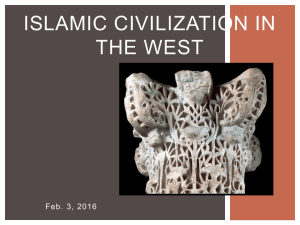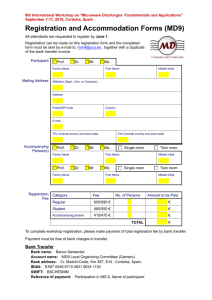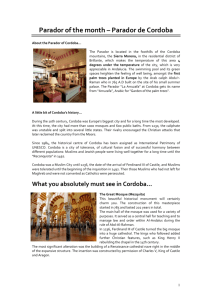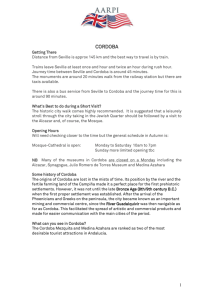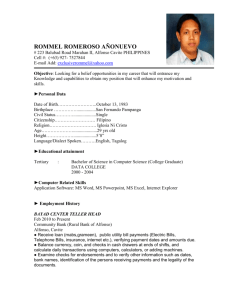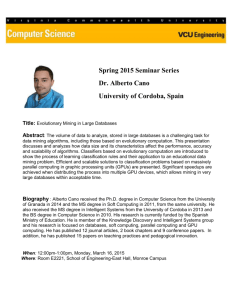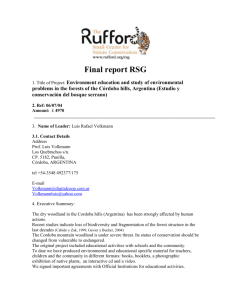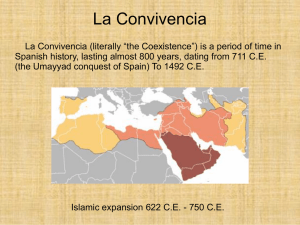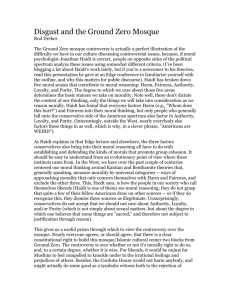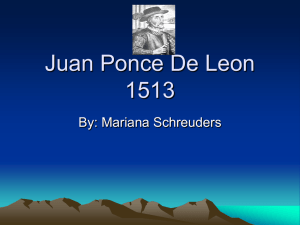study guide - Miami Theater Center
advertisement
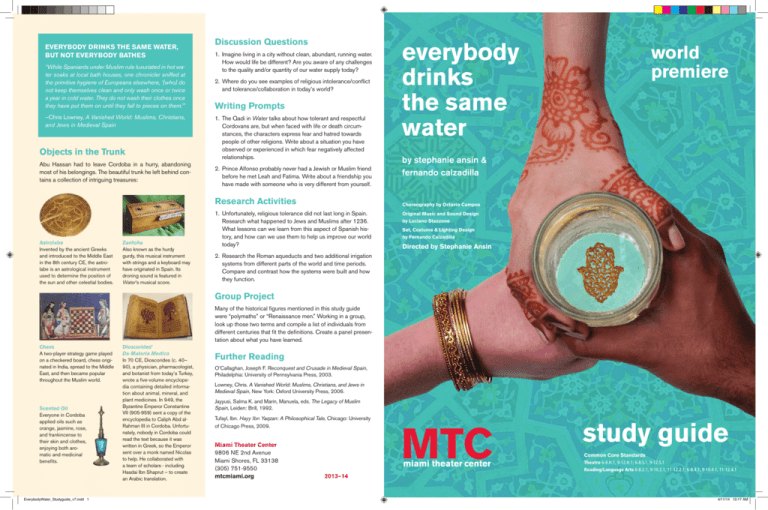
EVERYBODY DRINKS THE SAME WATER, BUT NOT EVERYBODY BATHES “While Spaniards under Muslim rule luxuriated in hot water soaks at local bath houses, one chronicler sniffed at the primitive hygiene of Europeans elsewhere, ‘[who] do not keep themselves clean and only wash once or twice a year in cold water. They do not wash their clothes once they have put them on until they fall to pieces on them.’” –Chris Lowney, A Vanished World: Muslims, Christians, and Jews in Medieval Spain Objects in the Trunk Abu Hassan had to leave Cordoba in a hurry, abandoning most of his belongings. The beautiful trunk he left behind contains a collection of intriguing treasures: Discussion Questions 1. Imagine living in a city without clean, abundant, running water. How would life be different? Are you aware of any challenges to the quality and/or quantity of our water supply today? 2. Where do you see examples of religious intolerance/conflict and tolerance/collaboration in today’s world? Writing Prompts 1. The Qadi in Water talks about how tolerant and respectful Cordovans are, but when faced with life or death circumstances, the characters express fear and hatred towards people of other religions. Write about a situation you have observed or experienced in which fear negatively affected relationships. 2. Prince Alfonso probably never had a Jewish or Muslim friend before he met Leah and Fatima. Write about a friendship you have made with someone who is very different from yourself. Research Activities Astrolabe Invented by the ancient Greeks and introduced to the Middle East in the 8th century CE, the astrolabe is an astrological instrument used to determine the position of the sun and other celestial bodies. Zanfoña Also known as the hurdy gurdy, this musical instrument with strings and a keyboard may have originated in Spain. Its droning sound is featured in Water’s musical score. everybody drinks the same water world premiere by stephanie ansin & fernando calzadilla Choreography by Octavio Campos 1. Unfortunately, religious tolerance did not last long in Spain. Research what happened to Jews and Muslims after 1236. What lessons can we learn from this aspect of Spanish history, and how can we use them to help us improve our world today? Original Music and Sound Design by Luciano Stazzone Set, Costume & Lighting Design by Fernando Calzadilla Directed by Stephanie Ansin 2. Research the Roman aqueducts and two additional irrigation systems from different parts of the world and time periods. Compare and contrast how the systems were built and how they function. Group Project Many of the historical figures mentioned in this study guide were “polymaths” or “Renaissance men.” Working in a group, look up those two terms and compile a list of individuals from different centuries that fit the definitions. Create a panel presentation about what you have learned. Chess A two-player strategy game played on a checkered board, chess originated in India, spread to the Middle East, and then became popular throughout the Muslim world. Scented Oil Everyone in Cordoba applied oils such as orange, jasmine, rose, and frankincense to their skin and clothes, enjoying both aromatic and medicinal benefits. EverybodyWater_Studyguide_v7.indd 1 Dioscorides’ De Materia Medica In 70 CE, Dioscorides (c. 40– 90), a physician, pharmacologist, and botanist from today’s Turkey, wrote a five-volume encyclopedia containing detailed information about animal, mineral, and plant medicines. In 949, the Byzantine Emperor Constantine VII (905-959) sent a copy of the encyclopedia to Caliph Abd alRahman III in Cordoba. Unfortunately, nobody in Cordoba could read the text because it was written in Greek, so the Emperor sent over a monk named Nicolas to help. He collaborated with a team of scholars - including Hasdai Ibn Shaprut – to create an Arabic translation. Further Reading O’Callaghan, Joseph F. Reconquest and Crusade in Medieval Spain, Philadelphia: University of Pennsylvania Press, 2003. Lowney, Chris. A Vanished World: Muslims, Christians, and Jews in Medieval Spain, New York: Oxford University Press, 2006. Jayyusi, Salma K. and Marín, Manuela, eds. The Legacy of Muslim Spain, Leiden: Brill, 1992. Tufayl, Ibn. Hayy Ibn Yaqzan: A Philosophical Tale, Chicago: University of Chicago Press, 2009. Miami Theater Center 9806 NE 2nd Avenue Miami Shores, FL 33138 (305) 751-9550 mtcmiami.org study guide Common Core Standards Theatre 6-8.H.1, 9-12.H.1; 6-8.S.1, 9-12.S.1 Reading/Language Arts 6-8.2.1, 9-10.2.1, 11-12.2.1; 6-8.4.1, 9-10.4.1, 11-12.4.1 2013–14 4/11/14 10:17 AM The Story A Brief History of Cordoba Water Everybody Drinks the Same Water takes place in Cordoba, a city in southern Spain. The action begins on June 21, 1236. Fernando III of Leon and Castille, a Christian king from northern Spain, has just taken power from a Muslim ruler, Abu Hassan, and moved into the alcazar (see photo) with his mother, Queen Berenguela, and his son, Prince Alfonso. Moments after entering the castle, Berenguela’s lady-in-waiting discovers that the alcazar has running water, a technology that has not yet reached northern Spain. She excitedly offers the king a glass. He drinks it and immediately falls gravely ill. Berenguela assumes that her son has been poisoned and begins to call on all her resources to help her discover the culprit. Evidence of settlement in Cordoba dates back to around 3000 BCE. The Romans conquered the area in 206 BCE, and Jews entered the region for the first time in 70 BCE when the Romans forced a large migration from Jerusalem to Cordoba. In early 5th century CE, the Visigoths, a Germanic tribe from northern Europe, took control of Cordoba and the entire Iberian Peninsula, today’s Spain and Portugal. In 711, Berbers, Muslims from North Africa, entered Southern Spain and overthrew the Visigoths, who had recently converted to Christianity. As a result, Spain became the site of the first encounter of Christians, Muslims, and Jews on western soil. Among the Roman’s many important contributions to the development of Cordoba are the two aqueducts they constructed in the 1st century BCE. These man-made channels used gravity to transport about 6.6 million gallons of water from the mountains to the city every day. That equals the capacity of 275,000 standard bathtubs! ALCAZAR a Spanish fortress or palace; origin: Spanish alcázar from Arabic al-qaṣr, the castle. www.merriam-webster.com/dictionary The Characters Fernando III of Castile and Leon (1199–1252) was the son of Berenguela of Castile and Alfonso IX of Leon. Although the action of the play revolves around King Fernando, we never actually see him on stage. Berenguela of Castile (1180–1246) was a shrewd politician and military strategist. She helped her son unite the kingdoms of Castile and Leon, designed the military campaign that led to his taking Cordoba, and governed the country with him until she died. Elvira Rodriguez (d.1255) provided the name for Berenguela’s lady-in-waiting. Her father, Gonzalo Rodríguez Girón, was the equivalent of Chief of Staff for Fernando, Berenguela, and her father, Alfonso VIII. Tello Alfonso de Meneses (no data) is the historical reference for Rodrigo, a knight in Water’s fictional court. Wealthy and noble, the Meneses were very loyal to Berenguela’s family. EverybodyWater_Studyguide_v7.indd 2 Cordoba’s Contributions to Society Alfonso X of Castile and Leon (1221–1284), Fernando III’s son, accompanied his father during the siege of Cordoba. He was left in charge of the city when Fernando got sick and returned home to Leon. (Fernando gets poisoned in the play, but according to history, he suffered from a chronic illness.) Alfonso later moved to Toledo where he established the School of Translators for scholars of all ethnicities and religions. He is known as Alfonso El Sabio (“The Wise”). Everybody Drinks the Same Water is an invention of the writers’ imaginations, but many of the characters were inspired by real people documented in historical records: The Doctor combines two of Cordoba’s famous Jewish citizens: Hasdai Ibn Shaprut (915–970), a diplomat and physician in the court of Muslim ruler Caliph Abd al-Rahman III (891–961), and Mosheh ben Maimon (aka Maimonides) (1135–1204), a rabbi, physician, philosopher, and astronomer. Leah and Fatima are the only characters without specific historical references. Their professions were chosen from the limited range of options available to women at the time. Leah, the Doctor’s niece, is studying to be a midwife. Fatima, the Qadi’s daughter, works as a copyist at court. The Qadi (Arabic for judge) is modeled after Ibn Rushd (aka Averroes) (1126–198), a Muslim physician, philosopher, astronomer, geographer, physicist, and qadi, and Ibn Tufayl (c. 1105 – 1185), a Muslim philosopher, physician, court official, theologian, and novelist. Building upon the Roman foundation, Cordovans developed one of the most advanced water systems in the world. They irrigated seeds imported from the Middle East and Egypt, transforming the dry Spanish countryside into lush fields and vegetable gardens. Water also flowed freely in beautiful fountains and bathhouses throughout the city. Literacy During the 5th century CE, Visigoths and Ostrogoths set fire to libraries across Western Europe and destroyed important classical Greek texts. Fortunately, copies of many of these books were safe in the cultural capitals of the Islamic world. When Muslims conquered southern Spain, they reconnected the West with its lost literary heritage, and by the 10th century, the main library of Cordoba had 400,000 hand-written books. In Northern Spain, only the Christian clergy and nobility could read and write, but nearly all the people of Cordoba were literate. Philosophy The Ancient Greek philosopher Aristotle was particularly influential on early Islamic thinkers. Jewish and Christian scholars translated Arabic versions of his texts into Latin, and philosophers of all three faiths expanded upon his system to create powerful intellectual tools for proving the existence of God through scientific inquiry. By the 10th century CE, Cordoba had become the greatest city in Europe. While the next largest city in Western Europe had a population of 10,000, half a million people lived in Cordoba, and the city boasted paved and lit streets; public hospitals; libraries; thousands of mosques, churches, and synagogues; 900 public bathhouses; over 2,000 private residences; 10,000 artisan shops; and the nickname “The Ornament of the World.” “People of the Book” Judaism, Christianity, and Islam were all born in the Middle East, and when Cordoba was under Muslim rule, followers of the three faiths were referred to as “people of the book” because of their religions’ shared origins in the Hebrew Bible. Medical Science Cordoba had 50 hospitals that both treated patients and trained doctors. Medicine was far more advanced than in other parts of Europe and clearly illustrated the multi-religious, multi-ethnic spirit of collaboration. Art Islam discourages the representation of people and animals in religious texts and architecture. As a result, Islamic artists created a tradition of intricate geometric designs and rhythmic patterns. The main set piece in Water is a giant, rotating tile with an Islamic design. 4/11/14 10:18 AM
